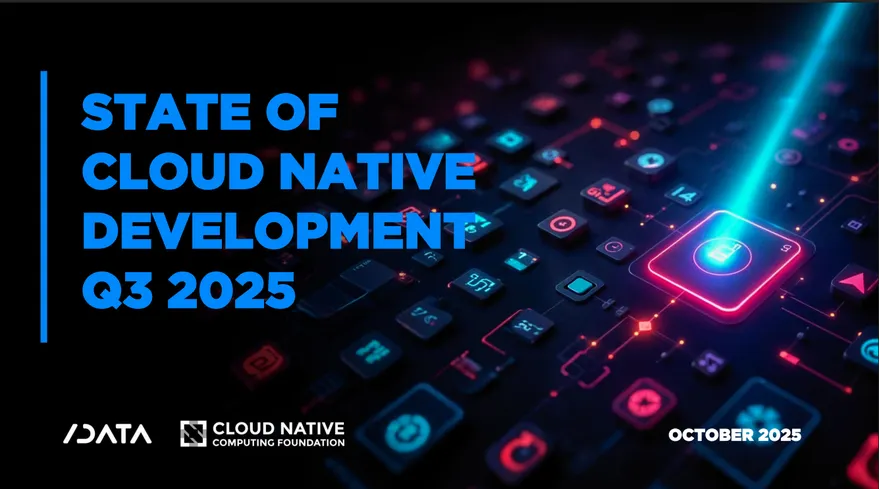
TL;DR
As of Q3 2025, 56% of backend developers qualify as cloud native, driven by strong adoption of API gateways and microservices, alongside growing use of hybrid (30%) and multi-cloud (23%) deployments across the developer ecosystem.
Key Points
Highlight key points with color coding based on sentiment (positive, neutral, negative).As of Q3 2025, 56% of backend developers are considered cloud native, with significant adoption of API gateways and microservices among this group.
Hybrid and multi-cloud deployments are increasingly popular, with 30% of developers using hybrid cloud and 23% using multi-cloud solutions, reflecting a trend towards more flexible and secure cloud strategies.
The adoption of cloud native technologies among ML/AI developers is lower, with only 41% being cloud native, largely due to the use of Machine Learning as a Service (MLaaS) which abstracts infrastructure management.
A substantial 77% of backend developers are using at least one technology associated with cloud native approaches, indicating widespread adoption of these technologies even if not all developers identify as cloud native.
The report highlights a three-phase adoption pattern of cloud native practices: foundational technologies like API gateways and microservices, sophisticated approaches such as Kubernetes and observability tools, and specialized practices like chaos engineering and immutable infrastructure.
Key Numbers
Present key numerics and statistics in a minimalist format.The percentage of backend developers considered cloud native in Q3 2025
The percentage of backend developers considered cloud native in Q1 2025
The share of all developers considered cloud native in Q3 2025
The total number of cloud native developers in Q3 2025
The number of cloud native developers involved in backend development in Q3 2025
The number of cloud native developers involved in machine learning or artificial intelligence in Q3 2025
The percentage of all developers deploying to hybrid cloud in Q3 2025
The percentage of all developers deploying to hybrid cloud in Q1 2021
The percentage of backend developers deploying to hybrid cloud that has remained stable since Q3 2023
The percentage of all developers using multi-cloud deployments in Q1 2021
The percentage of all developers using multi-cloud deployments in Q3 2025
The approximate percentage of backend developers using multi-cloud deployments since Q1 2022
The percentage of backend developers using distributed cloud in Q1 2025
The percentage of backend developers using distributed cloud in Q3 2025
The percentage of backend developers using API gateways
The percentage of backend developers operating microservices
The percentage of backend developers using observability tools
The percentage of backend developers using Kubernetes per the adoption table
The peak percentage of backend developers using Kubernetes in Q3 2023
The percentage of backend developers using event-driven architecture
The percentage of backend developers using streaming and messaging services
The percentage of backend developers using a front end gateway
The percentage of backend developers using remote procedure call
The percentage of backend developers using feature flagging
The percentage of backend developers using multicluster management
The percentage of backend developers reporting none of the listed technologies
The percentage of backend developers using service meshes in Q3 2025
The peak percentage of backend developers using service meshes in Q3 2023
The percentage of backend developers practicing immutable infrastructure
The percentage of backend developers practicing chaos engineering
The percentage of backend developers using at least one technology strongly associated with cloud native approaches
The current percentage of backend developers using containers per narrative statement
The approximate historical level for container usage among backend developers since Q3 2020
The percentage of professional DevOps developers classified as cloud native
The percentage of professional web backend developers classified as cloud native
The percentage of web frontend developers classified as cloud native
The percentage of developers creating third-party extensions classified as cloud native
The percentage of virtual reality developers classified as cloud native
The percentage of game developers classified as cloud native
The percentage of professional machine learning or artificial intelligence developers classified as cloud native
The percentage of machine learning or artificial intelligence developers using machine learning as a service platforms
The percentage of organizations where internal developer platform usage was reported in Q3 2025
The percentage of organizations where internal developer platform usage was reported in Q3 2024
The percentage of organizations with a dedicated team for developer experience in Q3 2025
The percentage of organizations with a dedicated team for developer experience in Q3 2024
The minimum number of survey respondents in the Q3 2025 wave
The number of countries represented in the introduction section statement
The number of countries reached as stated in the methodology section
The duration of the survey fieldwork period
The number of additional languages used for the survey beyond English
The number of global regions used for weighting in the methodology
The sample size for the backend technology adoption figure in Q3 2025
Stakeholder Relationships
An interactive diagram mapping entities directly or indirectly involved in this news. Drag nodes to rearrange them and see relationship details.People
Key entities and stakeholders, categorized for clarity: people, organizations, tools, events, regulatory bodies, and industries.Former experimental antimatter physicist with a PhD from CERN, contributing research and insights into the evolving landscape of cloud native development and its societal impact.
Analyst with a background in strategy and operations consulting, specializing in data-driven insights for complex business challenges within the tech and cloud sectors.
Organizations
Key entities and stakeholders, categorized for clarity: people, organizations, tools, events, regulatory bodies, and industries.Partners with SlashData to produce the State of Cloud Native Development report, providing analysis and insights into the cloud native ecosystem.
Independent analyst of the developer economy and publisher of the Developer Nation survey, providing global insights into developer trends and cloud native adoption.
Events
Key entities and stakeholders, categorized for clarity: people, organizations, tools, events, regulatory bodies, and industries.Large-scale online survey conducted between June and July 2025, reaching over 12,000 respondents across 127 countries to assess global cloud native development trends.
Industries
Key entities and stakeholders, categorized for clarity: people, organizations, tools, events, regulatory bodies, and industries.The primary focus of the report, analyzing adoption rates, tools, and methodologies shaping modern backend, DevOps, and ML/AI practices.
Timeline of Events
Timeline of key events and milestones.Containers became the dominant packaging standard, laying the groundwork for cloud native growth.
22% of developers used hybrid cloud and 17% used multi-cloud, marking the start of multi-environment strategies.
Kubernetes reached 36% usage and service meshes peaked at 18%, signaling early maturity before integration into broader platforms.
12% of backend developers adopted distributed cloud, exploring edge and hybrid-native models.
56% of backend developers are cloud native; hybrid (30%) and multi-cloud (23%) deployments are mainstream; SlashData and CNCF publish the 2025 report capturing five years of evolution.
The State of Cloud Native Development Q3 2025 report, produced by SlashData in partnership with the Cloud Native Computing Foundation (CNCF), offers a snapshot of how developers are building and scaling modern infrastructure.
Cloud native development is accelerating fast. In Q3 2025, 56% of backend developers now qualify as cloud native, a sharp rise driven by the convergence of backend web and cloud-native practices. Adoption of API gateways and microservices has reached 50% and 46%, forming the backbone of modern architectures. Yet only 30% of developers use Kubernetes directly, suggesting many rely on internal platforms or serverless abstractions that hide its complexity.
Hybrid and multi-cloud strategies continue to expand. About 30% of developers use hybrid cloud and 23% deploy across multiple providers, reflecting a shift toward compliance and security-focused architectures. Backend developers remain early adopters, setting patterns now spreading across other disciplines.
Machine learning tells a different story. Only 41% of ML and AI developers qualify as cloud native, largely because 29% depend on managed Machine Learning as a Service (MLaaS) platforms that offload infrastructure control.
The report outlines a three-phase adoption pattern: foundational technologies like API gateways and microservices, advanced tools such as Kubernetes and observability stacks, and specialized resilience practices like chaos engineering and immutable infrastructure. While usage is widespread, operational maturity still lags behind, leaving headroom for growth in how teams build truly resilient, cloud native systems.
Source: "State of Cloud Native Development – Q3 2025," published by SlashData in partnership with the Cloud Native Computing Foundation (CNCF). Licensed under CC BY-ND 4.0
Enjoyed it?
Get weekly updates delivered straight to your inbox, it only takes 3 seconds!Subscribe to our weekly newsletter DevOpsLinks to receive similar updates for free!
Give a Pawfive to this post!
Start writing about what excites you in tech — connect with developers, grow your voice, and get rewarded.
Join other developers and claim your FAUN.dev() account now!
FAUN.dev()
FAUN.dev() is a developer-first platform built with a simple goal: help engineers stay sharp without wasting their time.

DevOpsLinks #DevOps
FAUN.dev()
@devopslinks













